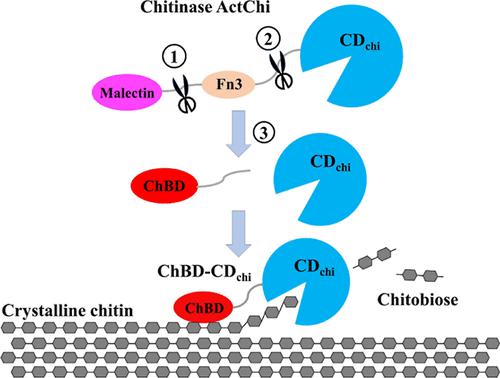当前位置:
X-MOL 学术
›
ACS Sustain. Chem. Eng.
›
论文详情
Our official English website, www.x-mol.net, welcomes your
feedback! (Note: you will need to create a separate account there.)
Discovering and Designing a Chimeric Hyperthermophilic Chitinase for Crystalline Chitin Degradation
ACS Sustainable Chemistry & Engineering ( IF 7.1 ) Pub Date : 2023-03-14 , DOI: 10.1021/acssuschemeng.2c07050
Bo Sun 1 , Xingchu Zhao 2 , Birui Xu 2 , Erzheng Su 3 , Andrey Kovalevsky 4 , Qirong Shen 1 , Dongyang Liu 1 , Qun Wan 1
ACS Sustainable Chemistry & Engineering ( IF 7.1 ) Pub Date : 2023-03-14 , DOI: 10.1021/acssuschemeng.2c07050
Bo Sun 1 , Xingchu Zhao 2 , Birui Xu 2 , Erzheng Su 3 , Andrey Kovalevsky 4 , Qirong Shen 1 , Dongyang Liu 1 , Qun Wan 1
Affiliation

|
Chitin is one of the most abundant renewable biopolymers on earth. However, it is highly crystalline and recalcitrant to degrade. Here, we report a hyperthermophilic chitinase (ActChi) to directly hydrolyze crystalline chitin at its optimal temperature of 80 °C. It contains a malectin domain, a fibronectin type-III (Fn3) domain, and a catalytic domain (CDchi). Both Fn3 and malectin have the function of chitin binding domain (ChBD) to increase the activity. Fn3 also significantly increases thermostability, but malectin decreases it. To enhance both activity and thermostability, we introduced a heterogeneous and hyperthermophilic ChBD at the N-terminus of CDchi to obtain ChBD-CDchi. The activity of this hybrid enzyme is 201 U/μmol for crystalline chitin, which has increased 400% compared with that of ActChi. In addition, ChBD-CDchi can continuously degrade crystalline chitin for more than 4 days at 70 °C to increase the overall hydrolysis rate. The strategy is a good example of green sustainable degradation for crystalline biopolymer in nature.
中文翻译:

发现和设计用于结晶几丁质降解的嵌合超嗜热几丁质酶
几丁质是地球上最丰富的可再生生物聚合物之一。然而,它是高度结晶的并且难以降解。在这里,我们报告了一种超嗜热几丁质酶 (ActChi),可在其最佳温度 80 °C 下直接水解结晶几丁质。它包含一个 malectin 结构域、一个 III 型纤连蛋白 (Fn3) 结构域和一个催化结构域 (CD chi )。Fn3和malectin都具有壳多糖结合结构域(ChBD)的功能以增加活性。Fn3 还显着提高了热稳定性,但 malectin 降低了它。为了提高活性和热稳定性,我们在 CD chi的 N 末端引入了异质和超嗜热的 ChBD以获得 ChBD-CD chi. 该杂合酶对结晶甲壳素的活性为201 U/μmol,与ActChi相比提高了400%。此外,ChBD-CD chi可在 70 °C 下连续降解结晶甲壳素 4 天以上,以提高整体水解速率。该策略是自然界中结晶生物聚合物绿色可持续降解的一个很好的例子。
更新日期:2023-03-14
中文翻译:

发现和设计用于结晶几丁质降解的嵌合超嗜热几丁质酶
几丁质是地球上最丰富的可再生生物聚合物之一。然而,它是高度结晶的并且难以降解。在这里,我们报告了一种超嗜热几丁质酶 (ActChi),可在其最佳温度 80 °C 下直接水解结晶几丁质。它包含一个 malectin 结构域、一个 III 型纤连蛋白 (Fn3) 结构域和一个催化结构域 (CD chi )。Fn3和malectin都具有壳多糖结合结构域(ChBD)的功能以增加活性。Fn3 还显着提高了热稳定性,但 malectin 降低了它。为了提高活性和热稳定性,我们在 CD chi的 N 末端引入了异质和超嗜热的 ChBD以获得 ChBD-CD chi. 该杂合酶对结晶甲壳素的活性为201 U/μmol,与ActChi相比提高了400%。此外,ChBD-CD chi可在 70 °C 下连续降解结晶甲壳素 4 天以上,以提高整体水解速率。该策略是自然界中结晶生物聚合物绿色可持续降解的一个很好的例子。

































 京公网安备 11010802027423号
京公网安备 11010802027423号